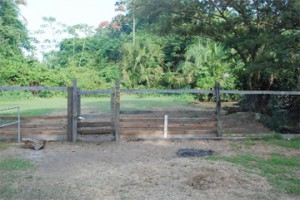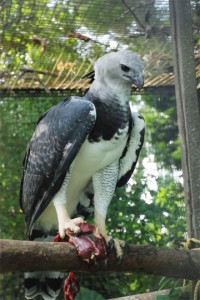…as huge aviary remains a dream five years on
A project funded by the Odense Municipality of Denmark to build a giant aviary for the harpy eagles at the Georgetown Zoo is still to materialize although more than five years have elapsed since the funds were provided for its construction.
On 11th April, 2003 the Mayor of the city of Odense and the Chairman of its zoo, Anker Boye, officially handed over US$30,000 towards the building of a giant cage at the back of the National Zoological Park near to where the old elephant cages were located.
The design of the cage was expected to facilitate trees in the vicinity of the proposed construction area being incorporated into the architecture. This would have allowed for the aviary to carry the dimensions and landscaping features similar to the natural habitats of the eagles.

The cage was expected to be 120 feet long, 60 feet wide and 50 feet high which would allow the eagles to move about with greater freedom than is currently permitted by their present cages.
The Ministry of Tourism, Industry and Commerce was one of the key players in this initiative and the then Minister, Manzoor Nadir, unveiled the cornerstone and turned the sod at the handing over ceremony. It was expected that the project would go up for tender and work would start as soon as this process was completed.
However, when Stabroek News visited the site identified for the cage, work on the aviary had not even been started. When questioned, the officials overseeing the zoo said that they were aware of plans to build the cage but did not know what had become of the project.
When this newspaper contacted the current Minister of Tourism, Industry and Commerce Manniram Prashad he said that although he was aware of the project, it does not fall under the purview of his Ministry. He said that the Office of the President would have responsibility for the project since that is the body that overlooks the National Parks Commission which had direct oversight of the venture.

However, repeated phone calls and even a visit by this newspaper to the office of General Manager of the National Parks Commission, Yolanda Vasconcellos proved futile in obtaining a comment from her.
When Inge Nathoo, the previous General Manager of the National Parks Commission, was asked about the project, she said that she “left her job as General Manager of the Commission 10 months ago and could not comment on the matter.”
Meanwhile, a former senior official attached to the Ministry of Tourism, Industry and Commerce said that the project has seemingly come to a standstill. He explained that the project had been handed over to the Department of Architecture at the University of Guyana for them to help in the design of the cage. And according to this official, this was the last he has heard about the venture.
Head of the Department of Architecture at the University of Guyana, Lennox Hernandez said that the project is no longer in the hands of his department. He said that initially the project had been handed over to Professor Rory Westmaas who was supposed to get a group of his students to work on it but nothing came out of this. He said that as far as he knows, the project was subsequently advertised as being up for tender in the local media.
The donation by the Odense Zoo was part of an ongoing sister-zoo relationship that it has with the Georgetown Zoo based on an agreement signed with the National Parks Commission in November 2001. Under this agreement four manatees were sent from the Georgetown Zoo to the Odense Zoo in order to re-energise the captive breeding in that territory.
The Harpy Eagle is the largest and most powerful raptor in the world and weighs over 25 lbs and is over 3 ft tall. The eagle has an average wing span of 6 1/2 feet. Its claws are as thick as a child’s wrist and are used for hunting. In Guyana, the eagle is indigenous to the Pakaraima and Kanuku Mountain ranges.




